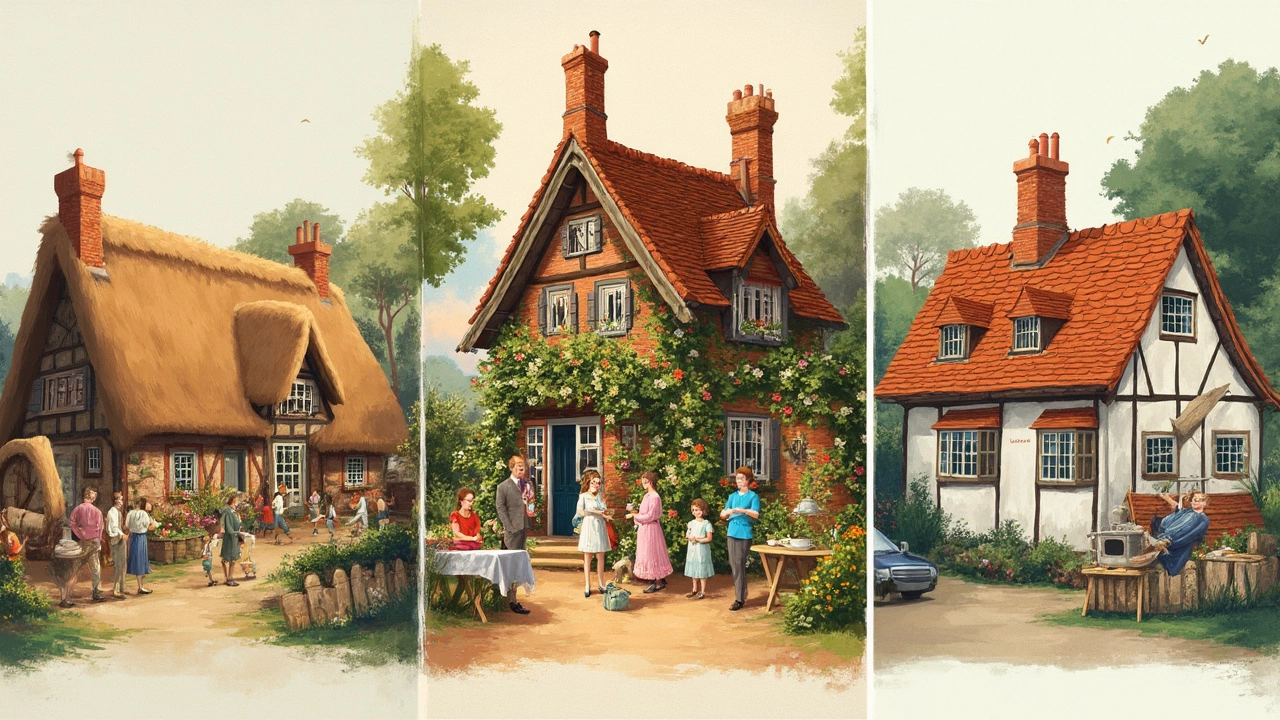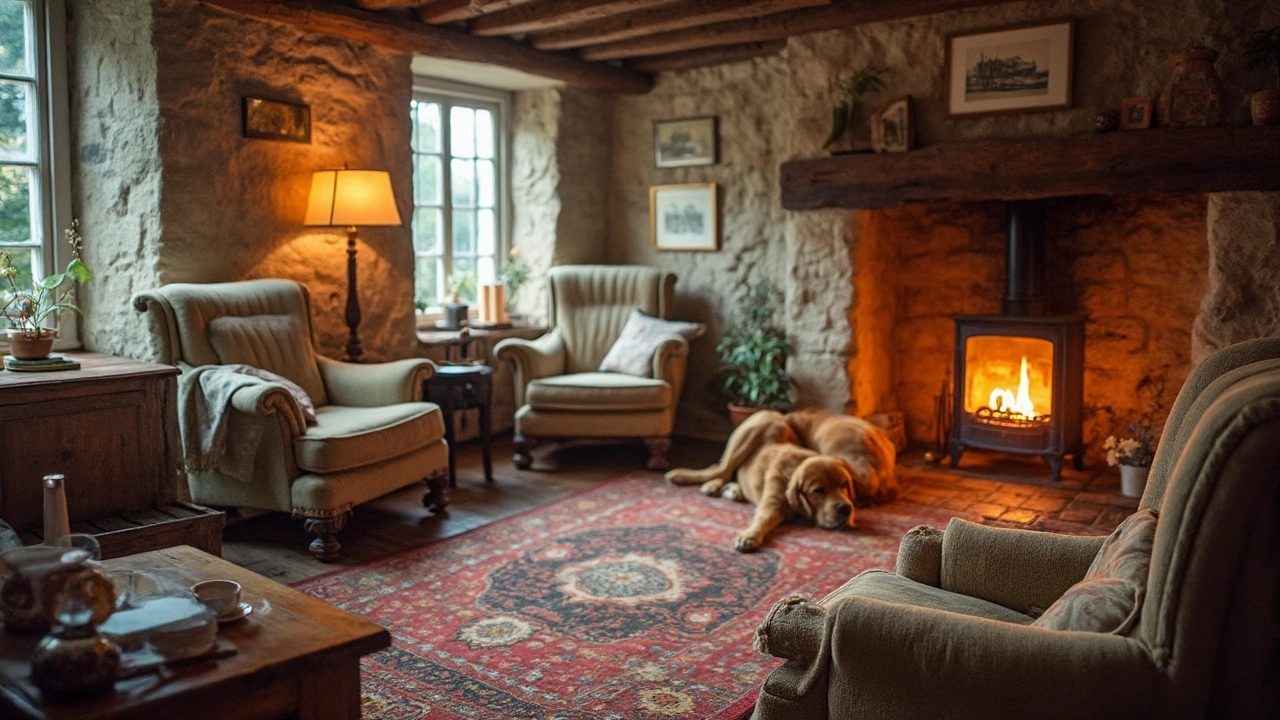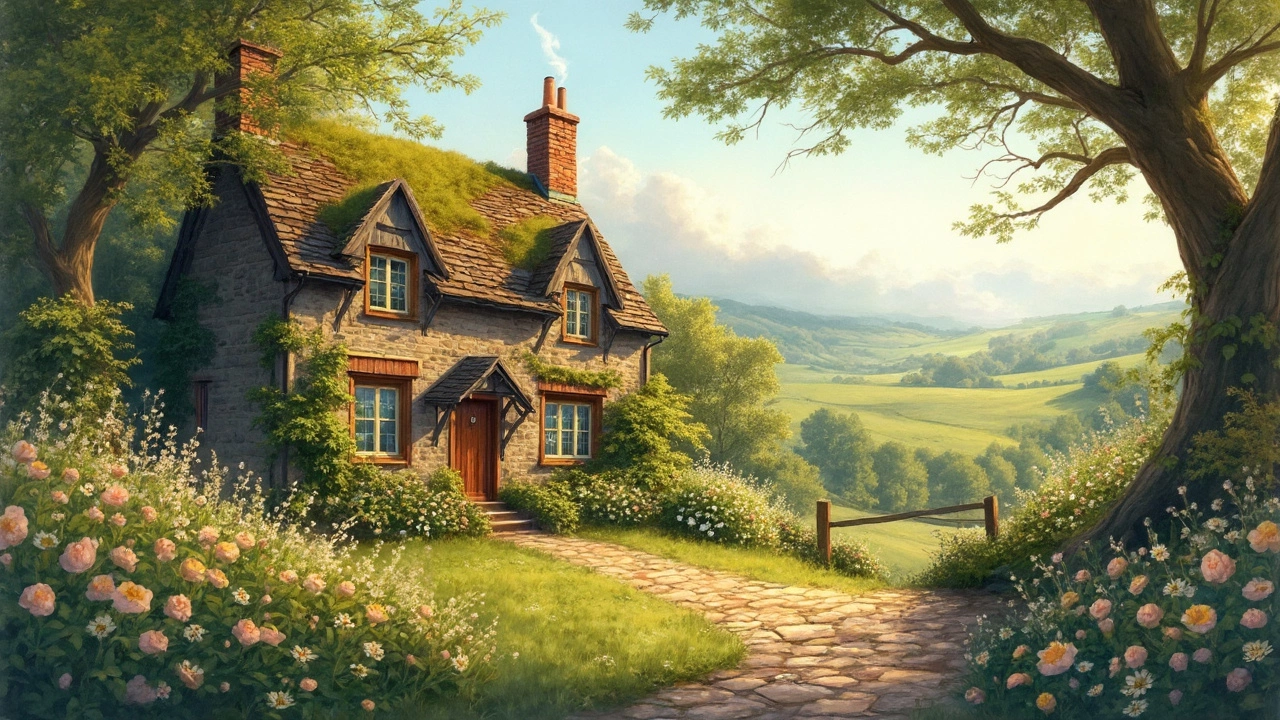Ever wondered why we call those cute countryside houses 'cottages'? The word isn't just random—it has deep roots going back hundreds of years. Most people picture a small house, maybe with flowers spilling out the front garden and smoke drifting from a chimney. But there’s a reason these escapes got their name, and it’s way more interesting than just 'a small house.'
When hunting for a last-minute cottage, it helps to actually know what makes a place a real cottage. You don’t want to end up in a modern block of flats, right? Understanding the cottage vibe means you’ll pick a place that actually feels like a break from normal life. A true cottage comes with a story, a particular look, and a certain comfort you can’t fake. Knowing what to look for keeps you from disappointment—especially when you’re booking fast.
- Where Does the Word 'Cottage' Come From?
- What Makes a True Cottage?
- Cottages in British Holiday Culture
- How Cottages Became a Last-Minute Trend
- Tips for Booking a Last-Minute Cottage Getaway
Where Does the Word 'Cottage' Come From?
The word "cottage" actually started out in England centuries ago. Back in the Middle Ages, a cottage wasn't just a small house. It was tied directly to the life of a "cotter"—basically someone who worked on a plot of land for a landlord in exchange for a simple home, usually made of local stone or wood with thatched roofs. You might be surprised to learn that owning a cottage at first meant you worked the land just enough to support yourself, but you didn't get much more than that little patch or the roof above your head.
Fast forward to the Tudor period and the word "cottage" became more common. But instead of city houses, it always referred to rural spots, almost always the homes of farm laborers and smallholders. The first official definitions even appeared in British law and property records by the 1500s. These records described a cottage as a home with just enough garden to support a family, never anything fancy or big.
If you look at the roots, "cot" is old English for a small house or shelter. Drop "cot" into everyday language, add the "-age" ending, and you get "cottage." Nothing fancy—just a practical label for a home that’s more about comfort and survival than showing off.
Why does this matter for today? Well, when you book a cottage now, you’re actually picking a place with a deep history tied to simple living and working lands. That’s probably why cottages have kept their down-to-earth, cozy feel even now—people are still after that escape from city stress, even if they don’t need to farm the land to pay the rent anymore.
What Makes a True Cottage?
Not every small house with old bricks gets to call itself a cottage. There are certain things that set a true cottage apart. It’s not just about size—it’s more about style, feel, and purpose.
A real cottage usually has thick stone or brick walls, a steeply pitched roof (often thatched in the old days), and windows that might look a bit odd by modern standards. You’ll often find low ceilings, exposed beams, and small, cozy rooms. Some cottages even have names painted right on the side because that's how villages used to work—no need for numbers when everyone knew each other's houses by name.
These houses were built for workers. In medieval England, "cottagers" were people with just enough land for a small garden and maybe a few chickens. Their homes were basic, designed around daily life without any extra fuss. Even now, that practical style carries over.
- Traditional building materials like stone, brick, or timber frame
- Compact layout with no wasted space
- Cozy fireplaces, often at the heart of the home
- Small gardens, sometimes with herbs or flowers
- Sloped roofs, sometimes using thatch or clay tiles
According to a report by Historic England, over 35,000 listed cottages are still standing today in the UK, with most built before 1850. Don’t be surprised to find features like narrow staircases, quirky doors, and slanting floors—these are signs of the real thing, not flaws.
| Feature | Typical in True Cottages? |
|---|---|
| Thatched Roof | Common (in older cottages) |
| Open Fireplace | Almost always |
| Stone/Brick Walls | Very common |
| Small Garden | Nearly always |
| Modern Interior | Rare, unless recently restored |
These days, people look for cottages as getaways from busy cities or just to unplug. But the basics haven’t changed much: comfort, charm, and a real sense of escape. When you book a cottage, check photos closely and look for these tell-tale signs—it’s the difference between a genuine experience and just another holiday rental.

Cottages in British Holiday Culture
Cottages aren’t just part of British scenery—they’re baked into how Brits unwind. For loads of people, the first family holiday they remember is a week away in a cottage somewhere green, far from city noise. Booking a cottage has even become a bit of a national tradition, especially for quick getaways. The idea really took off after World War II, when more families started taking short breaks instead of big, expensive trips abroad.
Britain’s famously unpredictable weather actually helped shape this trend. Who wants to camp in the rain? Cottages promised comfort—dry beds, real kitchens, and often a well-stocked bookshelf for rainy days. According to VisitBritain, over 25% of UK domestic holidays in 2023 were self-catering cottage stays. That’s a huge chunk of the market.
“For British families, the cottage holiday is less about luxury and more about simple pleasures—tea by the fire, muddy walks, and games around the kitchen table," says travel writer Lucy Miller in The Guardian.
The cottage holiday boom also means they're in almost every landscape you can imagine: from craggy Cornwall to Scotland’s wild Highlands. Some cottages today come with pools, saunas, or game rooms, but the old-school ones—whitewashed stone, low ceilings, a log burner—are still top of the wish list for many.
| Year | % of UK Holidaymakers Choosing Cottages |
|---|---|
| 2015 | 17% |
| 2019 | 21% |
| 2023 | 25% |
Looking for a cost-effective break? Cottages let you bring your own food, split the price with friends, and avoid expensive hotels. That flexibility is another reason they keep popping up as the first choice for spur-of-the-moment or big family trips.
- Choose a cottage near walking trails for a real taste of the countryside.
- Book during off-peak months for the best deals.
- Check for extras like wood burners or pet-friendly policies—they make a stay feel special.
How Cottages Became a Last-Minute Trend
Not that long ago, booking a cottage meant planning months ahead, especially for peak summer weeks. But that all changed big time once digital booking sites showed up. Suddenly, anyone could search for last minute cottages on their phone and find the perfect getaway, sometimes even for the same weekend. The rise of platforms like Airbnb and Booking.com totally flipped the script, making spontaneous trips easy and stress-free.
Here’s the real kicker—during the pandemic, travel rules pushed tons of people to look for nearby holiday options. British countryside cottages quickly became top picks since you could have privacy, your own kitchen, and distance from crowds. According to VisitBritain, domestic holiday bookings shot up by nearly 40% in 2021, with rural cottages being one of the most searched choices.
People got hooked on the flexibility too. No flights to worry about, and if the weather looks good, you just pack up and go. Booking systems started adding last-minute discounts, so waiting for a deal became almost a sport for some holidaymakers.
Just look at these numbers from 2024:
| Year | Last-Minute Cottage Bookings (UK) |
|---|---|
| 2019 | 210,000 |
| 2021 | 295,000 |
| 2024 | 385,000 |
The real appeal? It’s the chance to escape the city and breathe for a bit—even if you decide to go on Thursday and leave Friday after work. And with properties tailoring packages for weekend breaks, family getaways, and even solo escapes, cottages aren’t going out of style anytime soon.
- Book mid-week for the best prices.
- Subscribe to alerts—deals go fast.
- Look for properties with flexible check-in, so you’re not stuck in weekend traffic.
Most people love that feeling of adventure when you land a cozy spot at the last minute. For many, it’s become less about planning and more about grabbing those moments when you need them most.

Tips for Booking a Last-Minute Cottage Getaway
You’re down to the wire, searching for that perfect escape and hoping the ideal last minute cottages haven’t all been snapped up. Good news—there are smart ways to score a gem without the stress.
- Ditch the weekend routine. Midweek getaways are usually cheaper and more available. Most cottage owners bump up prices for Friday and Saturday nights, but Tuesday or Wednesday can mean a nicer spot for less money.
- Look beyond the hotspots. The big-name places—like the Lake District or Cotswolds—book up fast. Try less famous areas like Shropshire, Wiltshire, Northumberland, or Pembrokeshire. You’ll still get stunning scenery and often pay 20-30% less, especially in shoulder seasons.
- Set email alerts on big booking sites. Sites like Sykes, cottages.com, and Airbnb let you create alerts for last-minute deals. Some have 'late availability' pages that update daily, and it’s easy to set your price range.
- Double-check for hidden fees. Cleaning charges, short-stay surcharges, and pet fees can catch people off guard. It’s worth reading the small print before you hit book.
- Be flexible with amenities. If you need that open fire or hot tub, you might have to search longer or pay more. Set a checklist of must-haves versus nice-to-haves—especially when booking last-minute.
If you’re wondering what times of year usually offer the best pickings, check out this quick table:
| Best Times for Deals | Chance of Discount (avg.) |
|---|---|
| January - March | Up to 40% off |
| Late September - November | Up to 30% off |
| Outside School Holidays | Vastly improved, up to 50% off in some rural areas |
One last practical tip: always check the cancellation policy. Even last-minute bookings sometimes offer partial refunds or the chance to move your dates, just in case your plans change. And don’t hesitate to call or message the owner—they sometimes offer extra discounts if given the chance to fill an empty stretch.
